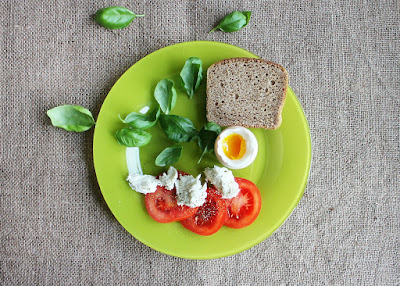Today I would like to talk about the difference between
caloric restriction at every meal and Intermittent Fasting. Especially in
regards to the question which strategy is more feasible as a long term strategy
to extend lifespan.
Research indicates that caloric restrictions leads to an
efficient metabolism and a slowed aging process. This can either be achieved by
general caloric restriction or by a restricted feeding window, also called
intermittent fasting. Both ways should lead to a decrease in caloric intake. And
finally it should be made clear that this article is evaluating the pros and
cons of these approaches in the light of life-long caloric restriction. In
short term many things might work if the goal is just fat-loss. For long-term
compliance more aspects need to be considered.
 |
| Do you prefer large meals... |
Intermittent Fasting
In my experience a shortened eating time during the day is
not enough to ensure such a caloric restriction. I find myself quite capable of
eating a big amount of food in one meal. Therefore attention to caloric intake
still has to be paid. With that said let’s discuss the advantages and
disadvantages of this approach:
Advantages:
- Less time spend preparing food and eating
- With fewer meals, one can eat to greater satiety after the meal
- Therefore, in theory, a caloric deficit is easier to achieve
- Feelings of hunger are compressed into one fasting window
- Hormone-release during the fasting period leads to increased fat utilization
- Easy to tailor around social eating events
- The relationship with food will be revealed (e.g. emotional eating)
Disadvantages:
- Challenging for some people to get all the required nutrients in one or two meals per day
- Once appetite is used to eating bigger meals it takes time to go back to several smaller meals
- Hunger or rather the feeling of an empty stomach might be an issue for some people
Regular Caloric Restriction
With regular caloric restriction I assume three meals a day
and a mainly or almost exclusively plant-based diet. Plant-based eating has
been shown to have life extension properties on it’s own if done correctly. A
healthful diet includes only whole foods and should make caloric restriction
easier because of increased satiety. Here are the Advantages and Disadvantages
of this approach compared to intermittent fasting:
Advantages:
- Smaller meals are easier to digest and assimilate leading to higher nutrient absorption
- Easier to plan even sized meals
- Regular eating might reduce hunger in some people
- High amount of vegetables can (needs) to be eaten at every meal to ensure satiety – this also leads to the advantage of high nutrient-density of the diet
- Higher intake to healthy high fiber foods possible
Disadvantages:
- Lower satiety at each meal, "the need to stop before satisfied"
- Harder to adjust to social eating (when portion sizes in restaurants are bigger)
- Might not fit some peoples schedule
- Meal preparation might be necessary
In the end it is a matter of preference. But just make sure
to give each approach a decent trial period before you judge it. Your body has
to adjust either way. Give it at least 30 days on each protocol.
In my next article I will discuss how I go about it and
combine fasting with regular caloric restriction to reap benefits of both
approaches.
